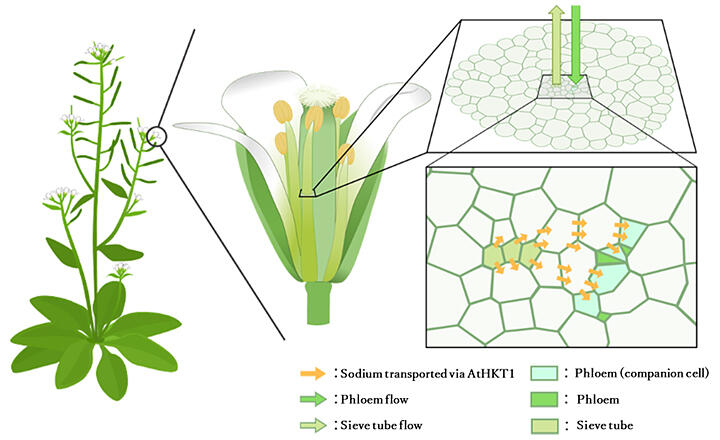A research group led by Graduate Student Takeshi Uchiyama, Associate Professor Yasuhiro Ishimaru, and Professor Nobuyuki Uozumi of the Graduate School of Engineering at Tohoku University, in collaboration with the Research Center for Electron-Photon Science, the Department of Quantum Science and Energy Engineering at the Graduate School of Engineering at the same university, Japan Women's University, the Institute for Environmental Sciences (IES), RIKEN, Shinshu University, and Okayama University, announced that they had elucidated the mechanisms by which the sodium transporter of Arabidopsis thaliana (AtHKT1) protects fertility from salt damage. They showed that this transporter is expressed in the stamen sieve tube and prevents sodium accumulation, which damages plants, in the stamen. Additional expression of the transporter in the sieve tube increased the seed yield under salt stress conditions compared to the yield of normal plants grown under the same conditions. The results are expected to lead to further research and the development of salt-tolerant plants. The results were published in the international academic journal Science Advances.

AtHKT1 is thought to transfer sodium from the phloem to the sieve tubes and send it back to the roots. This prevents excessive accumulation of sodium in the stamens and protects reproductive function.
Provided by Tohoku University
Although sodium (Na) is an essential element for humans, it is harmful to plants, and salt damage leads to desertification as well as reduced yields. One-fifth of the world's farmland is affected by salt damage due to seawater erosion, excessive fertilizer application, and groundwater spraying.
In 2000, the research group discovered and analyzed the structure and function of the sodium transporter AtHKT1 in Arabidopsis thaliana and showed that it functions in vessels and is involved in salt tolerance. As the transporter is abundantly expressed in roots, most previous research focused on roots, however, in this study, they further showed that this transporter is also expressed in the sieve tubes of flower stems.
In hydroponically grown Arabidopsis thaliana that lacked this transporter, the addition of salt to the culture medium after the flower stems began to elongate caused sodium accumulation in stamens, suppression of stamen elongation, and a subsequent reduction in seed yield. This accumulation did not occur in normal Arabidopsis thaliana. This transporter is thought to prevent sodium accumulation in stamens by moving sodium into the sieve tube for transport to the roots for elimination.
The research group also performed an experiment in which the transporter was overexpressed specifically in the sieve tubes of Arabidopsis thaliana, and salt was added stepwise (in concentrations of 30, 50, 75, and 100mM) to the culture after flower stems began to elongate.
The results showed that the seed and biomass yield of Arabidopsis thaliana overexpressing the transporter were about 1.5 and 2 times higher, respectively, than those of normal Arabidopsis thaliana under the same conditions. In Arabidopsis thaliana overexpressing the transporter, sodium remained around the ducts and sieve tubes in leaves and other above-ground areas, and sodium diffusion was suppressed. In normal Arabidopsis thaliana, sodium diffused throughout the leaves. The transporter is also present in other plants and is also carried by microorganisms such as E. coli, cyanobacteria and yeast. The reproductive organs (flower buds), which are critical sites for producing the next generation, are more sensitive to salt than other organs such as roots, suggesting that the AtHKT1 transporter functions in the stamens to mitigate salt inhibition as a mechanism to protect against salt stress.
Uozumi commented, "In the future, we would like to clarify the mechanism of adaptation to environmental stress by ion transporters including AtHKT1."
Journal Information
Publication: Science Advances
Title: The HKT1 Na+ transporter protects plant fertility by decreasing Na+ content in stamen filaments
DOI: 10.1126/sciadv.adg5495
This article has been translated by JST with permission from The Science News Ltd. (https://sci-news.co.jp/). Unauthorized reproduction of the article and photographs is prohibited.




